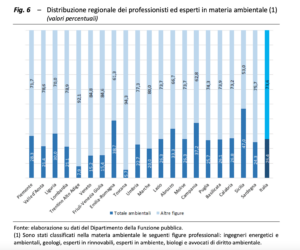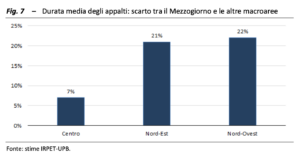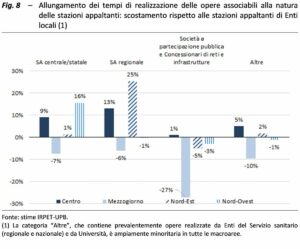Will the South be able to use funds from the NRP? Report

Funds Pnrr and Mezzogiorno. What the President of the Parliamentary Budget Office said at a hearing
In the last two years , considerable progress has been made in the implementation of fiscal federalism. As emerges from the hearing of the president of the Parliamentary Budget Office Lilia Cavallari on the structure of territorial finance and on the development lines of fiscal federalism, the budget laws for 2021 and 2022 have given a strong impetus to the design of the discipline relating to the Provinces and Metropolitan Cities.
In the two-year period of the pandemic, 12 billion paid to local administrations
In the two-year period of the pandemic, as stated in the text of the hearing of President Cavallari to the Parliamentary Commission for the implementation of fiscal federalism, various extraordinary measures were implemented to allow local authorities to face the economic and social consequences of the pandemic and to compensate the reduction of the revenue from taxes collected by local administrations. Local administrations received resources of 11.9 billion in 2020 and 2.8 billion in 2021, of which 8.5 to the municipalities, 1.1 to the provinces and metropolitan cities and 5.1 to the regions.
The reorganization of the relationship between the central state and territorial bodies
The emergency nature of these measures meant that the allocation of these resources had been made with measures adopted in conditions of urgency and outside an ordered regulatory framework. Therefore, the need emerged "to intervene in an incisive manner on the funding sources of the sector in order to rearrange its structure and make it consistent with the provisions of the delegated law on fiscal federalism", as stated in the report of the Parliamentary Budget Office . The first interventions came with the budget law for 2021 which established two distinct funds starting from 2022: one for the provinces and one for the metropolitan cities of the RSOs. These instruments will accommodate the contributions and funds currently allocated to these Bodies. The initial layout outlined by this provision was then integrated by the budget law for 2022 which "specified the methods of the equalization of the two funds and allocated additional contributions for the provinces and metropolitan cities for the performance of the fundamental functions" . These resources amount to 80 million for 202 2, 100 in 2023, 130 in 2024 and are destined to increase year by year to reach 600 million starting from 2031 .
LEP: federalism not inhomogeneity
In order for fiscal federalism not to translate into territorial disparities, the essential levels of benefits (LEP) must be respected. The LEP are “ interventions, services, activities and integrated services that the Republic ensures with a universality character throughout the national territory ”, as stated in the report. The LEP, concerning civil and social rights, have assumed a central role since the constitutional reform that rewrote Title V by eliminating the concept of national interest from the Constitutional Charter and "making it impossible to invoke it as a general limit to the exercise of regional legislative powers ”, As the text of the hearing presented to the Parliamentary Commission for the implementation of fiscal federalism points out. According to the constitutional provision , the financing of the LEP must be ensured by the taxes of the territorial bodies , by sharing and equalization transfers without destination restrictions. For the Regions the transfers were never carried out and for the Provinces and Metropolitan Cities they found a definitive structure only starting from this year. The Constitutional Court, with sentence 220/2021, condemned the delay in determining the LEP , which represents an obstacle both to the full implementation of the financial autonomy of the territorial bodies, and to the complete overcoming of territorial gaps in the enjoyment of benefits inherent to social rights .
The delay in determining the LEP
The LEP picture was only sketchy, remaining incomplete. The budget law for 2022, as stated in the report, tries to bring order to the LEPS in specific areas relating to welfare. A minimum level of places is established with reference to nursery schools and providing for the definition of objectives for increasing the transport of pupils with disabilities. Furthermore , the interventions on LEPS in the budget law for 2022 (Law 234/2021) were preceded by the Plan of interventions and social services 2021-2023. The budget law takes up the programmatic aspects of the Plan also due to the need to dictate a framework in which some interventions foreseen within the PNRR can be framed.
From PNRR up to 71 billion euros to local authorities
A significant portion of the resources activated by the PNRR will be managed by the territorial autonomies "as implementing subjects, or subjects who assume responsibility for the operational implementation of the interventions through the initiation, execution, monitoring and reporting of the same". The Parliamentary Budget Office estimates that the local authorities will manage amounts between approximately 66 and 71 billion of the Recovery and resilience facility , therefore, approximately, between 34.7 and 36.9 percent of the total of these resources allocated to the Italy for all the missions of the PNRR. Most of these are investments that the local authorities will have to manage, in ways that range from the direct use of resources to the preparation and transfer of resources to the final beneficiaries.
40% of resources in the South
The PBO wonders if the structures involved will be able to meet the efficiency requirements that the management of that large flow of money requires. 40 percent of the resources will be allocated to the South , in order to reduce the gaps between the various geographical areas, one of the objectives of the plan . "From an initial analysis by the Department for Cohesion Policies (DPCoe) of the Presidency of the Council of Ministers – in charge of monitoring compliance with the territorial constraint – it emerges that within the total resources taken into consideration, equal to 222.1 billion, of which 191.5 relating to the RRF and 30.6 to the FC, 211.1 billion were assessed as territorially allocable, of which 86 billion would be addressed to the South, satisfying – with a general share equal to 40.8 per cent – the destination constraint provided by the legislation ", reads the text of the UPB hearing.
Criticalities in resource management
The PBO notes three main criticalities:
- the ability of the central administrations to guide, through the activation of public tenders / notices, the allocation of funds between entities in a manner consistent with the specific and transversal objectives of the Plan;
- the adequacy of the administrative and technical structures of the subnational levels of government in preparing projects suitable for responding to the various lines of investment;
- the current times for carrying out the works, which reflect the different planning and management skills of the Regions and local authorities.
Formation of tenders and shortage of qualified personnel
As regards the first criticality, during the hearing the 36 calls published up to May 2 for the allocation of PNRR resources to local authorities were analyzed , for a total value of 24.3 billion, of which 43 billion , 3 per cent destined for the South. Different problems emerged from the analysis depending on whether national or regional rankings are envisaged. As regards the second critical element , the PBO notes that for many years the Public Administrations have seen a constant reduction in the staffing, due to the need to consolidate public accounts. In this context , the position of the South is even more problematic , as it has fewer qualified personnel, given that the permanent hiring involved the stabilization of socially useful workers (with unfavorable implications on generational turnover and on the possibility of personal integration with higher educational qualifications). The government tried to find a solution by increasing hiring , "the transfer of resources, the simplification and acceleration of insolvency procedures and the adoption of extensive training plans". The introduction of these tools does not guarantee, however, a direct increase in the administrative capacity of the territorial bodies, much will depend on their ability to exploit the possibilities made available by the PNRR.

Realizations of the works: the chronic delays of southern Italy
The third criticality concerns the times of realization of the works. The procurement procedures carried out between 2007 and 2021 showed that in the South and Islands times were on average 7% longer than in the Center , 21% compared to the North-East and 22% compared to the North-West. The PBO, in its hearing before the Parliamentary Commission for the implementation of fiscal federalism, focused on the performance of the contracted stations present on the national territory . The performances of the sub-contracted stations of the local authorities in the Center-North are very positive, especially if compared with the central or state stations, and with the procedures managed directly by publicly owned companies and by the concessionaires for the management of infrastructure networks.

As a result, the analysis conducted on the contracted stations of the local authorities of the South is diametrically "in which it is always advantageous that the contracting station is different from the local ones in such a way as to shorten the times by an average of 7 percent by relying on a central / state station, by 6 per cent by relying on a regional one and even by 27 per cent by letting publicly owned companies and concessionaires operate in their specific habits ". At the basis of this evidence is the performance gap (efficiency and effectiveness) between the public administrations of the Center-North and those of the South. "The procedures managed by publicly owned companies and concessionaires manage on average to free themselves from the level of performance of the territorial basin to which they belong".

This is a machine translation from Italian language of a post published on Start Magazine at the URL https://www.startmag.it/economia/il-sud-riuscira-a-utilizzare-i-fondi-del-pnrr-report/ on Sun, 15 May 2022 06:11:34 +0000.
